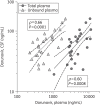Darunavir is predominantly unbound to protein in cerebrospinal fluid and concentrations exceed the wild-type HIV-1 median 90% inhibitory concentration
- PMID: 23143899
- PMCID: PMC3566670
- DOI: 10.1093/jac/dks441
Darunavir is predominantly unbound to protein in cerebrospinal fluid and concentrations exceed the wild-type HIV-1 median 90% inhibitory concentration
Abstract
Objectives: Higher CSF antiretroviral concentrations may be associated with better control of HIV replication and neurocognitive performance, but only the unbound fraction of antiretrovirals is available to inhibit HIV. Therefore, the objective of this study was to determine total and unbound darunavir concentrations in CSF and compare findings with plasma concentrations as well as the wild-type HIV-1 90% inhibitory concentration (IC(90)).
Methods: Subjects with HIV infection were selected based on the use of darunavir-containing regimens with a twice-daily dosing schedule and availability of stored CSF and matched plasma. Total darunavir was measured by HPLC for plasma or liquid chromatography-tandem mass spectroscopy (LC/MS/MS) for CSF. Plasma unbound darunavir was measured by ultrafiltration and LC/MS/MS. CSF protein binding was determined by competitive binding exchange with radiolabelled darunavir.
Results: Twenty-nine matched CSF-plasma pairs were analysed and darunavir was detected in all CSF specimens (median total concentration 55.8 ng/mL), with a CSF unbound fraction of 93.5%. Median fractional penetrance was 1.4% of median total and 9.4% of median unbound plasma concentrations. Unbound darunavir concentrations in CSF exceeded the median IC(90) for wild-type HIV in all subjects by a median of 20.6-fold, despite the relatively low fractional penetrance. Total darunavir concentrations in CSF correlated with both total and unbound darunavir concentrations in plasma.
Conclusions: Darunavir should contribute to the control of HIV replication in the CNS as a component of effective combination antiretroviral regimens.
Figures


References
-
- Ellis RJ, Hsia K, Spector SA, et al. Cerebrospinal fluid human immunodeficiency virus type 1 RNA levels are elevated in neurocognitively impaired individuals with acquired immunodeficiency syndrome. HIV Neurobehavioral Research Center Group. Ann Neurol. 1997;42:679–88. - PubMed
-
- Ellis RJ, Moore DJ, Childers ME, et al. Progression to neuropsychological impairment in human immunodeficiency virus infection predicted by elevated cerebrospinal fluid levels of human immunodeficiency virus RNA. Arch Neurol. 2002;59:923–8. - PubMed
-
- McArthur JC, McClernon DR, Cronin MF, et al. Relationship between human immunodeficiency virus-associated dementia and viral load in cerebrospinal fluid and brain. Ann Neurol. 1997;42:689–98. - PubMed
-
- Sevigny JJ, Albert SM, McDermott MP, et al. Evaluation of HIV RNA and markers of immune activation as predictors of HIV-associated dementia. Neurology. 2004;63:2084–90. - PubMed
Publication types
MeSH terms
Substances
Grants and funding
LinkOut - more resources
Full Text Sources
Medical

